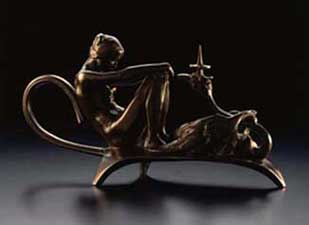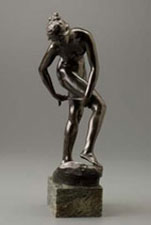
  
Over the 1890s to 1910s Melbourne-born sculptor Bertram Mackennal (1863-1931), who was based in London, became the most internationally successful artist that Australia had produced. Mackennal was one of a first generation of Australian born artists to travel to Europe to seek greater work opportunities and success. Mackennal was the first Australian artist to be elected to membership of the British Royal Academy, the first Australian to have work purchased for the British nation and the first Australian artist to be knighted. Under the patronage of George V Mackennal became one of Britain’s leading establishment artists in the early 20th century, with works located throughout that country and in India. His reputation in Britain far outshone that of contemporaries Tom Roberts, Arthur Streeton, George Lambert and Rupert Bunny for example, who had similarly travelled overseas to attempt success in Europe. Mackennal designed the 1908 London Olympic Games medals, the Coronation medal of 1911 and was the first non-Briton to design British coinage and postal stamps, which were in circulation throughout the Empire during the Georgian era. While Mackennal remained an expatriate, travelling back to Australia only three times, he maintained close links to local sculptors. He had a large impact on the growth and directions of sculpture in Australia. He completed a number of public works, including the Martin Place cenotaph, the figures of Archbishop Kelly and Cardinal Moran at St Mary’s Cathedral, and the Shakespeare memorial opposite the State Library – along with the monument to Edward VII, located on North Terrace in Adelaide, the monumental statue of Queen Victoria in Ballarat, the King Edward VII and Springthorpe memorials in Melbourne, and various statues of civic dignitaries in Brisbane and Perth. Mackennal’s Springthorpe memorial is the most spectacular example of Art nouveau and Symbolist-inspired sculpture in this country. In England, Mackennal rose to considerable sculptural prominence by creating the memorial tomb to King Edward VII and Queen Alexandra. He created Britain’s national memorial to Thomas Gainsborough in Suffolk (Gainsborough’s birthplace) and completed various sculptural projects for Britain’s royalty, including those executed for Lord Curzon, the Viceroy of India, and for the Duke of Norfolk at Arundel Castle. The national memorial to Edward VII, an equestrian statue of the King in the centre of London at Waterloo Place, is Mackennal’s, as are works in Westminster Abbey, York Minster, Winchester Cathedral, the Palace of Westminster and St Paul’s Cathedral. Mackennal is certainly one of the two most important sculptors Australia has produced. He became an exceptional avant-garde artist in the 1890s. Living in Paris in the mid 1880s and in contact with Rodin, Mackennal was strongly influenced by the progressive French interest in Florentine Renaissance traditions – a fact which British critics later attributed to the artist’s marked preoccupation with the eroticised body. Counting Sarah Bernhardt and Nellie Melba as intimate associates (he also produced busts of both women), Mackennal became renowned as the creator of beautiful, empathetic portraits of many of the era’s leading ‘new women’ (actresses, singers and socialites). Two of the most arresting of these works, the artist’s busts of Nellie Melba and young American socialite Miss Grace Dunham, will be included in the exhibition. Similarly Mackennal established a reputation in both Paris and London as the creator of bold, sensual, female nudes, His mythological female figures, such as Circe, Truth 1894, Salome c1897 and Venus, will also be included in the exhibition. The Bertram Mackennal exhibition, the Fifth Balnaves Foundation Sculpture Project, will feature 55 sculptures and an accompanying monograph on the artist – the first of its kind – which also includes a fully illustrated catalogue raisonné of Mackennal’s sculptures on CD-ROM. The monograph, featuring essays by leading sculpture experts in Australia, Britain, America and New Zealand, including eminent British historian Benedict Read, illustrates all of Mackennal’s major works. The Earth and the elements and the life-size figure Diana wounded will be part of the exhibition courtesy of the Tate in London. The Fifth Balnaves Foundation Sculpture Project Also supported by 
|